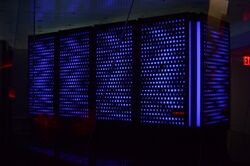Engineering:Anton (computer): Difference between revisions
John Stpola (talk | contribs) (add) |
(No difference)
|
Latest revision as of 20:07, 4 February 2024
Anton is a massively parallel supercomputer designed and built by D. E. Shaw Research in New York, first running in 2008. It is a special-purpose system for molecular dynamics (MD) simulations of proteins and other biological macromolecules. An Anton machine consists of a substantial number of application-specific integrated circuits (ASICs), interconnected by a specialized high-speed, three-dimensional torus network.[1]
Unlike earlier special-purpose systems for MD simulations, such as MDGRAPE-3 developed by RIKEN in Japan, Anton runs its computations entirely on specialized ASICs, instead of dividing the computation between specialized ASICs and general-purpose host processors.
Each Anton ASIC contains two computational subsystems. Most of the calculation of electrostatic and van der Waals forces is performed by the high-throughput interaction subsystem (HTIS).[2] This subsystem contains 32 deeply pipelined modules running at 800 MHz arranged much like a systolic array. The remaining calculations, including the bond forces and the fast Fourier transforms (used for long-range electrostatics), are performed by the flexible subsystem. This subsystem contains four general-purpose Tensilica cores (each with cache and scratchpad memory) and eight specialized but programmable SIMD cores called geometry cores. The flexible subsystem runs at 400 MHz.[3]
Anton's network is a 3D torus and thus each chip has 6 inter-node links with a total in+out bandwidth of 607.2 Gbit/s. An inter-node link is composed of two equal one-way links (one traveling in each direction), with each one-way link having 50.6 Gbit/s of bandwidth. Each one-way link is composed of 11 lanes, where a lane is a differential pair of wires signaling at 4.6 Gbit/s. The per-hop latency in Anton's network is 50 ns. Each ASIC is also attached to its own DRAM bank, enabling large simulations.[4]
The performance of a 512-node Anton machine is over 17,000 nanoseconds of simulated time per day for a protein-water system consisting of 23,558 atoms.[5] In comparison, MD codes running on general-purpose parallel computers with hundreds or thousands of processor cores achieve simulation rates of up to a few hundred nanoseconds per day on the same chemical system. The first 512-node Anton machine became operational in October 2008.[6] The multiple petaFLOP,[7] distributed-computing project Folding@home has achieved similar aggregate ensemble simulation timescales, comparable to the total time of a single continuous simulation on Anton, specifically achieving the 1.5-millisecond range in January 2010.[8]
The Anton supercomputer is named after Anton van Leeuwenhoek,[9] who is often referred to as "the father of microscopy" because he built high-precision optical instruments and used them to visualize a wide variety of organisms and cell types for the first time.
The ANTON 2 machine with four 512 nodes and its substantially increased speed and problem size has been described.[10]
The National Institutes of Health have supported an ANTON for the biomedical research community at the Pittsburgh Supercomputing Center, Carnegie Mellon University, and currently (8/20) continues with an ANTON 2 system.
See also
References
- ↑ David E. Shaw; Martin M. Deneroff; Ron O. Dror; Jeffrey S. Kuskin; Richard H. Larson; John K. Salmon; Cliff Young; Brannon Batson et al. (July 2008). Anton, a special-purpose machine for molecular dynamics simulation. 51. ACM. 91–97. doi:10.1145/1364782.1364802. ISBN 978-1-59593-706-3. http://cacm.acm.org/magazines/2008/7/5372-anton-a-special-purpose-machine-for-molecular-dynamics-simulation/fulltext. (Related paper published in Proceedings of the 34th Annual International Symposium on Computer Architecture (ISCA '07), San Diego, California, June 9–13, 2007).
- ↑ Richard H. Larson; John K. Salmon; Ron O. Dror; Martin M. Deneroff; Cliff Young; J.P. Grossman; Yibing Shan; John L. Klepeis et al. (2009). High-Throughput Pairwise Point Interactions in Anton, a Specialized Machine for Molecular Dynamics Simulation. IEEE. ISBN 978-1-4244-2070-4. http://www.cs.utah.edu/hpca08/papers/6A_1_Larson.pdf. Retrieved January 13, 2009.
- ↑ Jeffrey S. Kuskin; Cliff Young; J.P. Grossman; Brannon Batson; Martin M. Deneroff; Ron O. Dror; David E. Shaw (2009). Incorporating Flexibility in Anton, a Specialized Machine for Molecular Dynamics Simulation. IEEE. ISBN 978-1-4244-2070-4. http://www.cs.utah.edu/hpca08/papers/6A_2_Kuskin.pdf. Retrieved January 13, 2009.
- ↑ Cliff YoungExpression error: Unrecognized word "etal". (2009). "A 32x32x32, spatially distributed 3D FFT in four microseconds on Anton". Proceedings of the Conference on High Performance Computing Networking, Storage and Analysis. New York, NY: ACM. pp. 1–11. doi:10.1145/1654059.1654083. ISBN 978-1-60558-744-8.
- ↑ "National Resource for Biomedical Supercomputing". http://www.nrbsc.org/anton_rfp/.
- ↑ David E. Shaw; Ron O. Dror; John K. Salmon; J.P. Grossman; Kenneth M. Mackenzie; Joseph A. Bank; Cliff Young; Martin M. Deneroff et al. (2009) (Portland, Oregon). Millisecond-Scale Molecular Dynamics Simulations on Anton. New York, NY, USA: ACM. 1–11. doi:10.1145/1654059.1654099. ISBN 978-1-60558-744-8. http://cacs.usc.edu/education/cs653/Shaw-msMD-SC09.pdf. Retrieved April 20, 2012.
- ↑ Pande Group (Mar 2017). "Client Statistics by OS". Stanford University. http://fah-web.stanford.edu/cgi-bin/main.py?qtype=osstats.
- ↑ Vijay Pande (January 17, 2010). "Folding@home: Paper #72: Major new result for Folding@home: Simulation of the millisecond timescale". http://folding.typepad.com/news/2010/01/major-new-result-from-foldinghome-simulation-of-the-millisecond-timescale.html.
- ↑ John Markoff (July 8, 2008). "Herculean Device for Molecular Mysteries". The New York Times. https://www.nytimes.com/2008/07/08/science/08comp.html.
- ↑ Shaw, David E; Grossman, JP; Bank, Joseph; A Batson, Brannon; Butts, J Adam; Chao, Jack C; Deneroff, Martin M; Dror, Ron O et al. (2014). "Anton 2: Raising the Bar for Performance and Programmability in a Special-Purpose Molecular Dynamics Supercomputer". SC14: International Conference for High Performance Computing, Networking, Storage and Analysis. New Orleans, LA: ACM. pp. 41–53. doi:10.1109/SC.2014.9. ISBN 978-1-4799-5499-5.
External links


